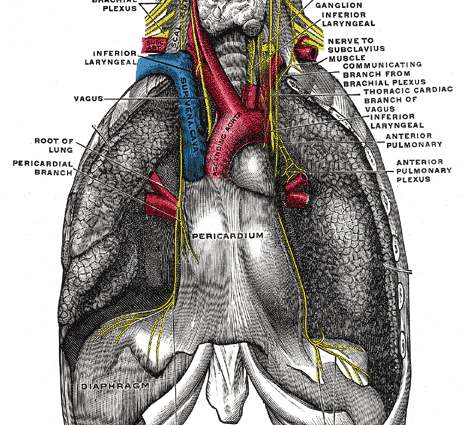Contents
Phrenic nerve
The phrenic nerve (from the ancient Greek phren, meaning diaphragm), formerly called the diaphragmatic nerve, has as its main function the innervation of the diaphragm.
Anatomy
Position. The phrenic nerve is located in the neck and thorax.
Structure. The phrenic nerve is the most important nerve originating from the cervical plexus. The phrenic nerve is a pair and mixed nerve, that is, composed of sensory and motor nerve fibers1,2. The phrenic nerve has motor innervation for the diaphragm and sensory innervation for the pleura, pericardium as well as for the supramesocolic peritoneum (3).
Origin. The nerve fibers of the phrenic nerve originate from the cervical vertebrae of the spinal cord: mainly from the C4 cervical vertebra and secondarily from the C3 and C5 cervical vertebrae (1).
Path. The phrenic nerve passes through the neck and thorax. It crosses the neck passing in front of the anterior scalene muscle, the neck muscle. The phrenic nerve also passes between the subclavian artery and the subclavian vein. It then continues its journey through the thorax, passing in front of the root of the lung. It crosses the diaphragm at two points, to the right and to the left (2).
Collateral branches. Several branches arise from the phrenic nerve: thymic, pleural, pericardial branches, as well as a branch for the superior vena cava (2).
Nerve endings. The phrenic nerve has several endings: the anterior, lateral and posterior phrenic-abdominal branches (2).
Function of the phrenic nerve
Role in respiration. The phrenic nerve innervates the diaphragm and drives the main movements of breathing (1).
Pathologies associated with the phrenic nerve
Damage to the phrenic nerve can cause diaphragm problems and lead to breathing problems.
Hiccups. When the phrenic nerve is irritated, it causes irregular flow to the diaphragm. The latter reacts in spasms, causing phrenoglottic myoclonus, more commonly called hiccups. In some very rare cases, hiccups can be chronic and last for long periods (1).
Paralysis of the diaphragm. Certain trauma and certain pathologies can cause compression or rupture of the phrenic nerve. This usually results in partial or total paralysis of the diaphragm, preventing normal breathing movements.
Treatments
Phytotherapy or homeopathy. Depending on the pathology diagnosed, certain herbal or homeopathic treatments can be used.
Physical treatment. Physical therapies can be prescribed such as osteopathy or acupuncture.
Surgical treatment. During respiratory arrest, surgery may be performed. Among these operations, one distinguishes: ventilation which uses a mechanical ventilator connected to the subject by tracheotomy; or phrenic stimulation which uses electrodes stimulating the phrenic nerve.
Examination of the phrenic nerve
Physical examination. First, a clinical examination is performed in order to identify and assess the symptoms perceived by the patient.
Medical imaging exam. Radiography can be used to confirm or further a diagnosis. Dynamic fluoroscopy can also be done to analyze diaphragm movement.
Anecdote
Hiccups can be chronic and last for several years. In the 68th century, Charles Osborne hiccupped continuously for XNUMX years.
Record created : July 2016 Author : Quentin Nicard |










